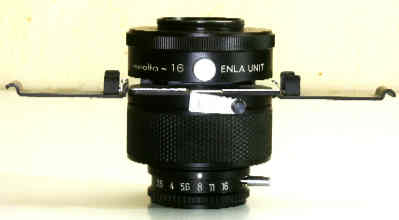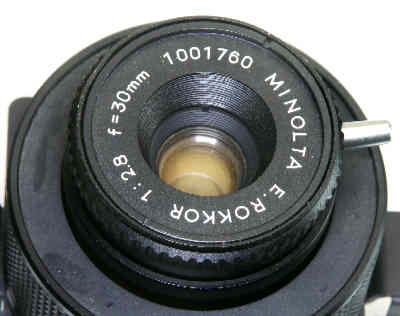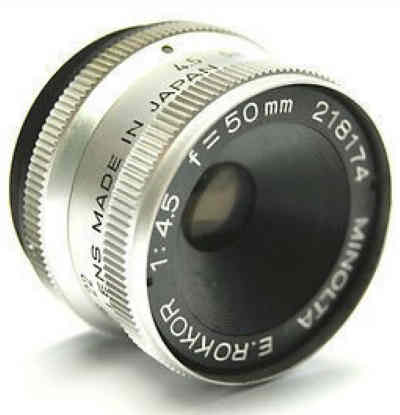
MINOLTA ENLARGER LENSES

Most people don't know it, but Minolta made a lot of darkroom gear -- enlarger lenses, enlargers, color analyzers, and much more -- for MANY formats. Everything they made was not just top-of-the-line, it was designed for super-easy use in the dark! Here are the enlarging lenses that they made. Their designations can be confusing because they changed their labeling over time. You will see lenses with the following labels, even though some of them are exactly the same optically:
Most of these lenses can be used on any enlarger from any company because they all had the standard 39mm Leica thread. There were Minolta lenses to fit every need from submini (10x14mm) to 6X9 medium format.
-- This lens came on the Minolta Mini 16 Enlarger. Chrome body and black faceplace. The four element lens stops down to f11. Designed for 10x14mm negatives with an image circle of 18mm. Since Minolta made its first 16mm camera in 1955, this lens probably appeared shortly thereafter. It may or may not have been sold without the enlarger. In any case, it is VERY hard to find, especially without the enlarger.

-- This lens was also sold on the Minolta Mini 16 Enlarger. Like the 25mm it has four elements, and apertures to f11. Much easier to find than the 25mm, but slightly slower. Chrome body. Designed for 10x14mm negatives -- but the slightly larger image circle of 23mm covers the larger images on the Minolta MG-s & QT cameras (12x17mm).

-- The enla-unit is comprised of a standard subminiature lens with a negative stage, negative holder and condenser assembly to be used in conjunction with a normal enlarger to allow for subminiature enlargements. The normal lens is removed from the enlarger and the enla-unit is screwed-in in its place. The submini negative is then placed in the negative holder of the enla-unit and enlarged on the baseboard. Since the enla-unit has its own condenser assembly and focusing mount, the minimum focusing distance of the enlarger itself is no longer an obstacle to printing. Minolta's Enla has a black body with f-stops from f2.8 through f16.0. Minolta made negative carriers for 10x14mm and 12x17mm negatives. The unit has a focusing ring, so the lens is not focused using the enlarger's normal focusing knob. The unit screws into any Leica-thread (39mm) lens board. Rotating positioning collar at the top. The Minolta ENLA came with a red plastic sheet that could be cut and inserted into the negative carrier of the enlarger to serve as a red safe-light. Designed for 10x14mm and 12x17mm negatives.


-- A multi-coated, six-element in five groups enlarging lens of superb quality for B&W and color enlarging -- that's what the "CE" means. It is optimized for magnifications of 26X! It sports a standard Leica thread, click-stop override, and illuminated f-stops on BOTH sides of the lens. Oversized design makes it easy to use. Recessed design, so it will work with just about any enlarger. Designed for 10x14mm to 13x17mm (110 & Kiev) negatives.

-- The same as above, but for non-US markets.

-- The same as above, but Minolta dropped the Rokkor name.

-- First style of this enlarging lens. Chrome body. Designed for 24x36mm negatives -- and similar sized negatives, since Minolta at first made many cameras with 24x32mm, 24x33mm, and 24x34mm images.

-- Second style with indented, black face plate.

-- Final style that has a flat face plate and is slightly larger.

-- A multi-coated, six-element in five groups enlarging lens of superb quality for B&W and color enlarging -- that's what the "CE" means. It sports a standard Leica thread, click-stop override, and illuminated f-stops on BOTH sides of the lens. Designed for 24x36mm negatives.

-- The same as above -- without the "X" -- but for non-US markets.

-- The last Minolta enlarging lens. Like all the other Rokkor lenses, it too lost the Rokkor name, and was only called Minolta. But it's really the same lens as the 50mm 2.8 CE-Rokkor. Designed for 24x36mm negatives.

-- First style enlarging lens. Chrome body. Designed for 6x6cm and similar-sized negatives.

-- Second style enlarging lens. Chrome body with black face plate. Designed for 6x6cm and similar-sized negatives.

-- Another, slightly slower style enlarging lens. Chrome body with black "art deco" face plate. Designed for 6x6cm and similar-sized negatives.

-- The last, and most common 75mm enlarging lens. Chrome body with black face plate. Designed for 6x6cm and similar-sized negatives.

-- A multi-coated, six-element in four groups enlarging lens of superb quality for B&W and color enlarging. It sports a standard Leica thread, click-stop override, and illuminated f-stops. Designed for 6x6cm and 6x7cm negatives.

-- The same as above, but for non-US markets.

-- The same as above, but Minolta dropped the Rokkor name.

-- Minolta made a LOT of medium format cameras in its early years, so of course they made a medium format enlarging lens, early on. Apertures to f22. Designed for 6x6 to 6x9cm negatives. Chrome body and no faceplate. VERY hard to find.

-- A later version with the Minolta name, now with a black face-plate. Designed for 6x6 to 6x9cm negatives. Chrome body with black faceplate. A little easier to find.

In addition, Minolta made several enlargers and numerous accessories for formats from 16mm to medium format.

RETURN TO THE MANUAL MINOLTA HOME PAGE
COPYRIGHT@1995-2025 by Joe McGloin.
All Rights Reserved. The material on this website is protected by US Federal copyright laws. It cannot be copied
or used in any manner without specific approval from the owner.